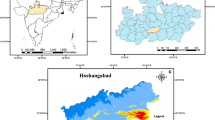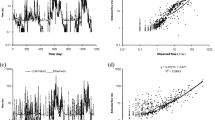Abstract
Rainfall–Runoff Models (RRMs) are standard tools for hydrologists to organize water resource planning and management. With the development of space-information technology and computing science in recent years, RRMs have improved to better simulate the rainfall–runoff process along with the spatial variation of simulated catchment, with the aim of precisely articulating the underlying relationship between input and output information. The Artificial Neural Network (ANN) model is suitable because it has various mathematical compositions capable of simulating a nonlinear structural system to establish the flow discharge in a catchment. For this reason, it has been successfully applied in RRMs modeling. In this study, the rainfall–runoff behavior of the gauge stations will be replicated in an ANN model. A Back-Propagation Neural network (BPN) was adopted to estimate an ungauged region’s outflow considering the temporal distribution of rainfall–runoff and the spatial distribution of the watershed environment. The nonlinear relationship among the physiographic factors, precipitation and outflow of the specific catchment was established to estimate the outflow of the sub-catchment where no flow gauge had been provided. The hazard preventive hourly model was mainly considered in this paper, and the model was also compared with the Instantaneous Unit Hydrograph (IUH) and Area Ratio Method (ARM) approaches. In validation tests in the middle and large catchments in Taiwan, the model performed well in providing forecast results. From the research work, it is revealed that the relevant spatial information can be obtained easily and precisely, which will help future studies on more related dimensions.
Similar content being viewed by others
References
Ahmad M, Ghumman A, Ahmad S (2009) Estimation of Clark’s instantaneous unit hydrograph parameters and development of direct surface runoff hydrograph. Water Resour Manag 23:2417–2435
Al-Qudah K, Abu-Jaber N (2009) A GIS database for sustainable management of shallow water resources in the Tulul al Ashaqif Region, NE Jordan. Water Resour Manag 23:603–615
Bowden GJ, Maier HR, Dandy GC (2002) Optimal division of data for neural network models in water resources applications. Water Resour Res 38:2-1–2-11. doi:10.1029/2001WR000266
Chan SC (2003) Flood estimation using artificial neural network based on physiographic features of watersheds. Ph.D., National Taiwan University
Cigizoglu HK, Kişi Ö (2005) Flow prediction by three back propagation techniques using k-fold partitioning of neural network training data. Nord Hydrol 36:49–64
Corani G, Guariso G (2005) An application of pruning in the design of neural networks for real time flood forecasting. Neural Comput Appl 14:66–77. doi:10.1007/s00521-004-0450-z
Cutore P, Cristaudo G, Campisano A, Modica C, Cancelliere A, Rossi G (2007) Regional models for the estimation of streamflow series in ungauged basins. Water Resour Manag 21:789–800
Dooge J, O’Kane JP (2003) Deterministic methods in systems hydrology. Balkema, Lisse
Ellouze M, Abida H (2008) Regional flood frequency analysis in Tunisia: identification of regional distributions. Water Resour Manag 22:943–957
Engeland K, Hisdal H (2009) A comparison of low flow estimates in ungauged catchments using regional regression and the HBV-model. Water Resour Manag 23:2567–2586
Franchini M, Suppo M (1996) Regional analysis of flow duration curves for a limestone region. Water Resour Manag 10:199–218. doi:10.1007/BF00424203
Gupta VK, Waymire E, Wang CT (1980) A representation of an instantaneous unit hydrograph from geomorphology. Water Resour Res 16:855–862. doi:10.1029/WR016i005p00855
Ham FM (2001) Principles of neurocomputing for science and engineering. McGraw Hill, New York
Haykin SS (1999) Neural networks. Prentice Hall, Hamilton
Horton RE (1945) Erosional development of streams and their drainage basins: hydrophysical approach to quantitative morphology. Geol Soc Amer Bull 56:275–370. doi:10.1130/0016-7606(1945)56[275:edosat]2.0.co;2
IAHS (2002) IAHS Decade of the prediction of ungauged basins. IAHS Newsletter 74
Jain SK, Singh RD, Seth SM (2000) Design flood estimation using GIS supported GIUHApproach. Water Resour Manag 14:369–376
Johnson DE (1998) Applied multivariate methods for data analysis. Duxbury, Pacific Grove
Kuo YM, Liu CW (2000) Analysis on variation of groundwater quality in Yun-Lin coastal area: (I) Multivariate factor analysis method. Journal of Taiwan Water Conservancy 48:1–8
LeBoutillier DW, Waylen PR (1993) A stochastic model of flow duration curves. Water Resour Res 29:3535–3541. doi:10.1029/93WR01409
Lin MW (2006) Time series analysis and forecasting, 3rd edn. Hwatai, Taipei
Liu L-M, Hanssens DM (1982) Identification of multiple-input transfer function models. Commun Stat, Theory Methods 11:297–314
Maier HR, Dandy GC (2000) Neural networks for the prediction and forecasting of water resources variables: a review of modelling issues and applications. Environ Model Softw 15:101–124
Mimikou M, Kaemaki S (1985) Regionalization of flow duration characteristics. J Hydrol 82:77–91
Noto L, La Loggia G (2009) Use of L-moments approach for regional flood frequency analysis in Sicily, Italy. Water Resour Manag 23:2207–2229
Patil J, Sarangi A, Singh O, Singh A, Ahmad T (2008) Development of a GIS Interface for estimation of runoff from watersheds. Water Resour Manag 22:1221–1239
Ponce VM (1989) Engineering hydrology: principles and practices. Prentice Hall, Englewood Cliffs
Quimpo RG, Alejandrino AA, McNally TA (1983) Regionalized flow duration for philippines. J Water Resour Plan Manage 109:320–330. doi:10.1061/(ASCE)0733-9496(1983)109:4(320)
Rodríguez-Iturbe I, Valdés JB (1979) The geomorphologic structure of hydrologic response. Water Resour Res 15:1409–1420. doi:10.1029/WR015i006p01409
Sanborn SC, Bledsoe BP (2006) Predicting streamflow regime metrics for ungauged streamsin Colorado, Washington, and Oregon. J Hydrol 325:241–261. doi:10.1016/j.jhydrol.2005.10.018
Sarangi A, Madramootoo C, Enright P, Prasher S (2007) Evaluation of three unit hydrograph models to predict the surface runoff from a Canadian watershed. Water Resour Manag 21:1127–1143
Sefton CEM, Howarth SM (1998) Relationships between dynamic response characteristics and physical descriptors of catchments in England and Wales. J Hydrol 211:1–16. doi:10.1016/S0022-1694(98)00163-2
Simon H (1999) Neural networks: a comprehensive foundation, 2nd edn. Prentice Hall, New Jersey
Spearman C (1904) General intelligence, objectively determined and measured. Am J Psychol 15:201–293
Strahler AN (1952) Hypsometric (area-altitude) analysis of erosional topography. Geol Soc Amer Bull 63:1117–1142. doi:10.1130/0016-7606(1952)63[1117:haaoet]2.0.co;2
Venkata R, Eldho T, Rao E, Chithra N (2008) A distributed kinematic Wave–Philip infiltration watershed model using FEM, GIS and remotely sensed data. Water Resour Manag 22:737–755
Wagener T, Wheater H, Gupta HV (2004) Rainfall–runoff modelling in gauged and ungauged catchments. Imperial College Press, London
Wei WWS (2006) Time series analysis: univariate and multivariate methods. Addison Wesley, Redwood City
Wilcock DN, Hanna JE, Essery CI (1987) Derivation of flow duration curves in Northern Ireland. In: Proceedings of the Institute of Civil Engineers Part 2, pp 381–396
Woods R (2002) Seeing catchments with new eyes. Spatial patterns in catchment hydrology: observations and modelling. In: Grayson R, Blöschl G (eds) Hydrol Process, vol 16, pp 1111–1113. doi:10.1002/hyp.539
Yu PS, Yang TC (1996) Synthetic regional flow duration curve for southern Taiwan. Hydrol Process 10:373–391. doi:10.1002/(SICI)1099-1085(199603)10:3<373::AID-HYP306>3.0.CO;2-4
Zhu ML, Fujita M (1994) Comparisons between fuzzy reasoning and neural network methods to forecast runoff discharge. J Hydrosci Hydraul Eng 12:131–141
Author information
Authors and Affiliations
Corresponding author
Rights and permissions
About this article
Cite this article
Chen, CS., Chou, F.NF. & Chen, B.PT. Spatial Information-Based Back-Propagation Neural Network Modeling for Outflow Estimation of Ungauged Catchment. Water Resour Manage 24, 4175–4197 (2010). https://doi.org/10.1007/s11269-010-9652-6
Received:
Accepted:
Published:
Issue Date:
DOI: https://doi.org/10.1007/s11269-010-9652-6




